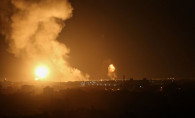The Forgotten International Treaties on the Legal Boundaries of Israel between Israel and the United Nations
The Forgotten International Treaties on the Legal Boundaries of Israel between Israel and the United Nations
In 1947, the United Kingdom (UK) turned the decolonization of the Palestine problem over to the United Nations (UN) as the mandatory Power. After looking at alternatives, the UN proposed terminating the Mandate and partitioning Palestine into two independent States, one Palestinian Arab and the other Jewish, with Jerusalem internationalized with the UN General Assembly (UNGA) Resolution 181 of 29 November 1947.
In the last preamble paragraph of the UNGA Resolution 181, UNGA recommended from the UK as the mandatory Power for Palestine, and to all other Members of the UN the adoption and implementation, with regard to the future government of Palestine, of the Plan of Partition with Economic Union set out as written. But even if the UNGA resolution 181 used the wording recommend, in the operative paragraph (a) UNGA requested from the UN Security Council (UNSC) that:
“The Security Council take the necessary measures as provided for in the plan for its implementation;”
In the operative paragraph (c), the UNGA defined any attempt to alter by force the settlement envisaged by its resolution should be understood under the UN Charter, Chapter VII namely “Action with Respect to Threats to the Peace, Breaches of the Peace, and Acts of Aggression” and asked the UNSC to act accordingly as:
“The Security Council determine as a threat to the peace, breach of the peace or act of aggression, in accordance with Article 39 of the Charter, any attempt to alter by force the settlement envisaged by this resolution;”
In general, UNGA resolutions are considered recommendations and have no binding power, but UNGA resolution 181 is an exception. The UNGA resolution 181 has binding effect as long as it creates boundaries based on decolonization. When the UNGA asked the UNSC in the operative paragraph (c) of its resolution to act accordingly to Chapter VII of the UN Charter, the UNSC entered into an obligation for the protection of UNGA resolution 181. The UNGA resolution 181 has a binding character and is still binding today.
On November 29, 1947, after the UN approved resolution 181calling for the division of Mandate Palestine into two entities—one for Jews and one for Arabs. The leadership of the Yishuv (term used to describe the Jewish community of Palestine) decided to declare the establishment of the Jewish state on 14 May 1948. This was the day before the UK were to complete their withdrawal from Mandate Palestine. The Declaration of Independence of Israel was issued on 14 May 1948. In the Declaration of Independence, the territory of Israel was defined as:
“THE STATE OF ISRAEL is prepared to cooperate with the agencies and representatives of the United Nations in implementing the resolution of the General Assembly of the 29th November, 1947”
Israel defined its frontiers as subject to the UN General Assembly Resolution 29 November 1947. When Israel's Declaration of Independence linked itself with Chapter XII of the UN Charter, the declaration gained an erga omnes character as declaration it incorporates a jus cogens norm. It was linked as:
“WE DECLARE that, with effect from the moment of the termination of the Mandate being tonight, the eve of Sabbath, the 6th Iyar, 5708 (15th May, 1948),”
On 29 November 1948, Israel applied to the membership of the UN by sending a letter to the Secretary-General of the UN. In the first paragraph of the letter, Israel had linked its admission to the UN with the UNGA Resolution 181 and with its Declaration of independence proclaimed 14 May 1948 as:
“On May 14 1948, the independence of the State of Israel was proclaimed by the National Council of the Jewish people in Palestine by virtue of the natural and historic right of the Jewish people to independence in its own sovereign State and in pursuance of the General Assembly resolution of November 29, 1947.”
In the fourth paragraph of the letter, it is written that:
“A formal declaration that the Government of Israel accepts all the obligations stipulated in the UN Charter is enclosed.”
In addition, a declaration was signed by Moshe Shertok, Minister for Foreign Affairs of the Provisional Government of Israel. The declaration mentioned that the State of Israel accepted the obligations arising from the UN Charter
Upon its admission letter, Israel stated that in accordance with UNGA resolution 181 of 29 November 1947, its boundaries would be defined. Accordingly, Israel has committed to withdrawing from the territories it occupied during the First Arab–Israeli War. Israel reaffirms these with its declaration given to the UNSC once again and redefines its boundaries in accordance with UNGA resolution 181. Israel admitted to the UN on 11 May 1949 with the UNGA resolution 273.
In the preamble paragraph 2 Resolution 273 of the UNGA, it is written that:
“Noting that, in the judgment of the Security Council, Israel is a peace-loving State and is able and willing to carry out the obligations contained in the Charter,”
In the preamble paragraph 4 of UNGA resolution 273, it is written that:
“Noting furthermore the declaration by the State of Israel that it "unreservedly accepts the obligations of the United Nations Charter and undertakes to honor them from the day when it becomes a member of the United Nations,”
In the preamble paragraph 5 of UNGA resolution 273, it is written that:
“Recalling its resolutions of 29 November 1947 and 11 December 1948 and taking note of the declarations and explanations made by the representative of the Government of Israel before the Ad Hoc Political Committee in respect of the implementation of the said resolutions,
In the operative paragraph 1 of UNGA resolution 273, it is written that:
“Decides that Israel is a peace loving State which accepts the obligations contained in the Charter and is able and willing to carry out those obligations;”
When Israel admitted to the UN, the letter of Israel to the UNSC, Declaration of Independence of Israel and the declaration of Israel for its admission to the UN became international treaties between the UN and Israel. The existence of Two State for the old Palestine mandate of the League of Nations, one Palestine State and One Israel State in fact was realized by the UN with these international treaties.
The UN Charter forbade conquest and Israel as well refused conquest as a legal right especially to itself in its application to the UN to be a member State and accepted its boundaries subject to UNGA resolution 181.
Most importantly, Israel became a member of the UN subject to its withdrawal from the territories it occupied after the First Arab-Israel War. The UNGA resolution 273 has a binding character under the UN Charter on the withdrawal of Israel from the territories that Israel occupied during the First Arab-Israel War.
The boundaries of Israel as written in the UNGA resolution 273 when Israel admitted to the UN has a legal binding effect on the UNSC and the UNSC has no authority under the UN Charter on any modification on the boundaries of Israel.
Unfortunately, the letter of Israel to the UNSC, the Declaration of Independence of Israel and the declaration of Israel for its admission to the UN are as forgotten international treaties between Israel and the UN.
Prof.h.c Mehmet Sukru Guzel
President of Center for Peace and Reconciliation Studies,







